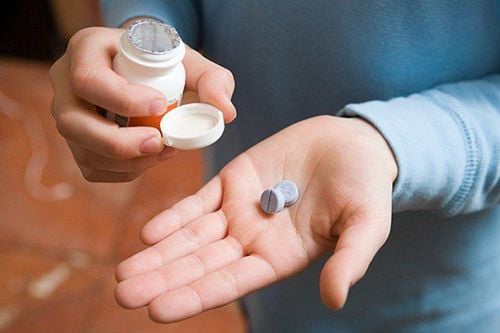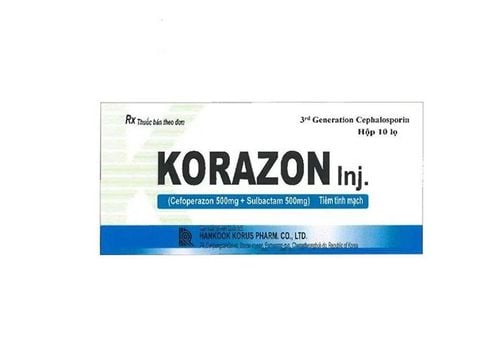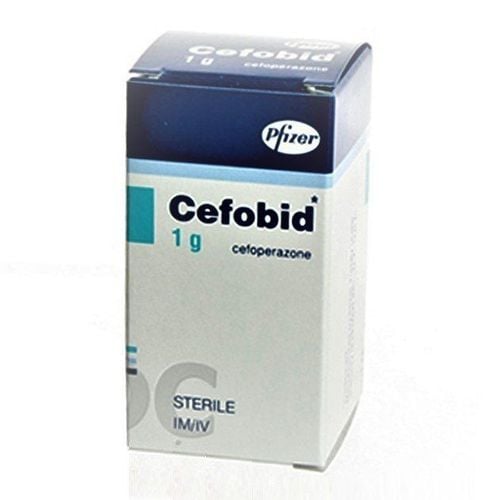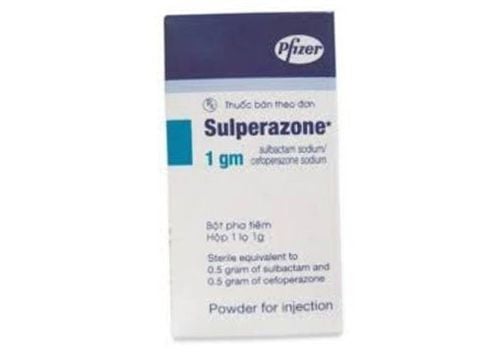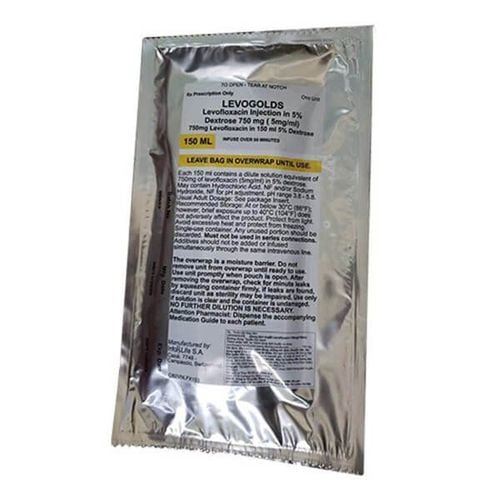This is an automatically translated article.
Alemctum is a parasitic, anti-infective, anti-viral, anti-fungal drug indicated for the treatment of a number of infectious diseases such as respiratory infections, urinary tract infections.... Here is the information. about Alemctum that users need to know before being prescribed the drug to ensure the safest and most effective use.
1. What is Alemctum?
Alemctum is a pharmaceutical product manufactured and registered by Alembic., Ltd – India.
Alemctum belongs to the group of antiparasitic, anti-infective, antiviral, antifungal drugs with the main active ingredient being Cefoperazone (in the form of Cefoperazone sodium) 500mg and Sulbactam (in the form of Sulbactam Sodium) 500mg. The drug is often indicated for the treatment of infectious diseases such as upper and lower respiratory tract infections, urinary tract infections, cholecystitis, peritonitis...
The drug is prepared in sterile powder for injection and Packing box 1 vial 1g contains 500mg Cefoperazone and 500mg Sulbactam.
2. Uses of Alemctum
2.1. The effect of the drug Alemctum Cefoperazone in Alemctum is a semi-synthetic antibiotic belonging to the 3rd generation Cephalosporin group, with bactericidal effect. Cefoperazone administered parenterally has antibacterial activity similar to ceftazidime. Cefoperazone is active against a broad spectrum of gram-negative bacteria, including penicillinase-producing gonorrhoeae and most strains of Enterobacter, Proteus, Morganalle, Citrobacter, Providencia, Shigella, Salmonella and Serratia spp.
The effect of Cefoperazone against Enterobacteriaceae is weaker than that of other 3rd generation Cephalosporins. Cefoperazone is usually active against bacteria resistant to other beta-lactam antibiotics. The active ingredient sulbactam in Alemctum is structurally similar to beta - lactam but has very weak antibacterial activity, so it is not used alone in clinical practice.
When bound to beta lactamase, Sulbactam inactivates this enzyme, thus protecting the antibiotics with beta lactamase structure from degradation. Therefore, Sulbactam is used in combination with penicillin group to expand the spectrum of action of penicillin against bacteria that secrete beta lactamase such as: E.coli, enteric bacteria, staphylococcus, Branhamella, Neisseria, Klebsiella, Proteus and anaerobic bacteria Bacteroides, Acinobacter.
2.2. Indications for drug use Alemctum Alemctum drug containing cefoperazone and sulbactam is usually indicated to treat a number of infectious diseases such as:
Respiratory tract infections; Urinary tract infections ; Cholecystitis, biliary tract, peritoneal and other inflammatory abdominal diseases; Blood infection, meningitis ; Skin and soft tissue infections; Bone and joint infections; Pelvic infections, gonorrhea, endometritis, and other genital infections. 2.3 Contraindications to the use of Alemctum Alemctum is contraindicated in the following cases:
People with a history of allergy to penicillin group antibiotics; Hypersensitivity to Sulbactam, Cefoperazone or other Cephalosporin antibiotics.
3. Usage – Dosage of Alemctum
Alemctum is only used as directed and prescribed by a qualified doctor, so patients need to adhere to the way and dose prescribed by the doctor.
How to use:
The drug is prepared in the form of powder for injection, so it can be used intramuscularly or intravenously. The preparation and administration of injections and infusions must be performed by a physician or qualified medical professional and all infusion equipment must be sterile. Dosage:
Adults with mild and moderate infections take 1-2g (Cefoperazone) every 12 hours, and severe infections use 2-4g every 12 hours. Normal dose in children: 25-100mg/kg every 12 hours. Renal impairment: No dose reduction is required. Liver disease or biliary obstruction should not exceed 4g/24 hours. Note: Apply the exact dose prescribed by your doctor or according to the manufacturer's instructions printed on the product. Absolutely do not arbitrarily calculate and adjust the dose that may cause side effects affecting health.
4. Alemctum . side effects
Overall, the drug was well tolerated and most of the side effects were mild and moderate.
Clinical studies have shown that, when using Alemctum, some of the following side effects may occur:
Digestive system: nausea, vomiting and diarrhea. Skin system: erythema, urticaria. Hematopoietic system: Long-term use of the drug can cause reversible leukopenia, positive Coomb's reaction, decrease in hemoglobin and red blood cells, transient eosinophilia, thrombocytopenia and hypoprothrombinemia.
5. Drug interactions
Alcohol or alcohol-containing preparations: Caution should be taken when taking cefoperazone and sulbactam with alcoholic drugs or alcohol-containing preparations that can cause reactions such as: hot flashes, headache, sweating, tachycardia . Aminoglycoside antibiotics: Cefoperazone / Sulbactam and other Aminoglycosides should not be mixed together, which will reduce the drug's activity. When using the combination of Sulbactam / Cefoperazone and Aminoglycosides, it is necessary to interrupt the infusion, wash the infusion tube between the 2 doses or use it at intervals. Lidocaine : The reconstituted solution should not be made initially with 2% lidocaine HCl and the suspensions are incompatible. Be careful when combining with thrombolytic drugs, anticoagulants, non-steroidal anti-inflammatory drugs due to the potential for bleeding. The drug should not be mixed with Amikacin, Ajmalin, Doxycycline, Diphenhydramine, Gentamicin, Kanamycin B, Meclofenoxate, potassium magnesium aspartate to avoid precipitation. To avoid drug interactions, patients need to inform their doctors about all the drugs they are taking for more appropriate instructions and indications.
6. Notes and cautions when using Alemctum
When using Alemctum, patients also need to note and be extra cautious with the following issues to ensure safety, effectiveness, and limit side effects of the drug, namely:
The drug is only used Use only when prescribed by a qualified doctor, so it is necessary to use the drug according to the dose prescribed by the doctor. Do not arbitrarily change, adjust the dose, use of the drug without being prescribed by the doctor. Cefoperazone and sulbactam should be used with caution in patients with a history of penicillin allergy. Pseudomembranous colitis has been reported in patients receiving Cefoperazone and other broad-spectrum antibiotics. Patients should not drink alcohol while using Cefoperazone injection and Sulbactam. For pregnant women, the drug should not be used, only when absolutely necessary under the direction and supervision of a specialist. For lactating women, the drug is rarely excreted in breast milk, but caution should be exercised when administering the drug to a nursing woman. In clinical studies, Alemctum did not affect the ability to drive or use machines.
7. Handling missed dose, drug overdose Alemctum
Missed dose: Usually, if you miss a dose, you can take it within 1-2 hours of the prescribed time. If it is almost time for your next dose, skip the missed dose and continue with the next scheduled dose. Do not take a double dose to make up for a missed dose to avoid overdose or increased side effects.
Overdose: There have been reports of side effects occurring with Alemctum overdose, which can cause side effects on the nervous system in people with renal failure. In the event of an overdose due to renal failure, hemodialysis can remove cefoperazone and sulbactam from the body.
When there are signs of suspected overdose when taking the drug, it is necessary to notify the doctor or take the patient to the nearest medical center for emergency treatment and timely treatment.
8. How to store Alemctum
Should store the medicine in a dry place with a temperature below 30 degrees C and avoid moisture, avoid direct sunlight. Keep the medicine out of reach of small children to avoid children playing, taking the wrong medicine can cause poisoning and affect health.
Consult your doctor or contact your local waste disposal company for advice on how to safely dispose of your medicine when it has expired or is no longer in use. Note that drugs and drug packaging should not be thrown into the toilet, nor flushed under the household tap.
Hope that the above information has helped people know the use of Alemctum, as well as the appropriate dose and usage. Note, this is a prescription drug, so patients should not use it on their own, but need to contact a specialist directly to get an appropriate prescription to ensure safety for health.
.




